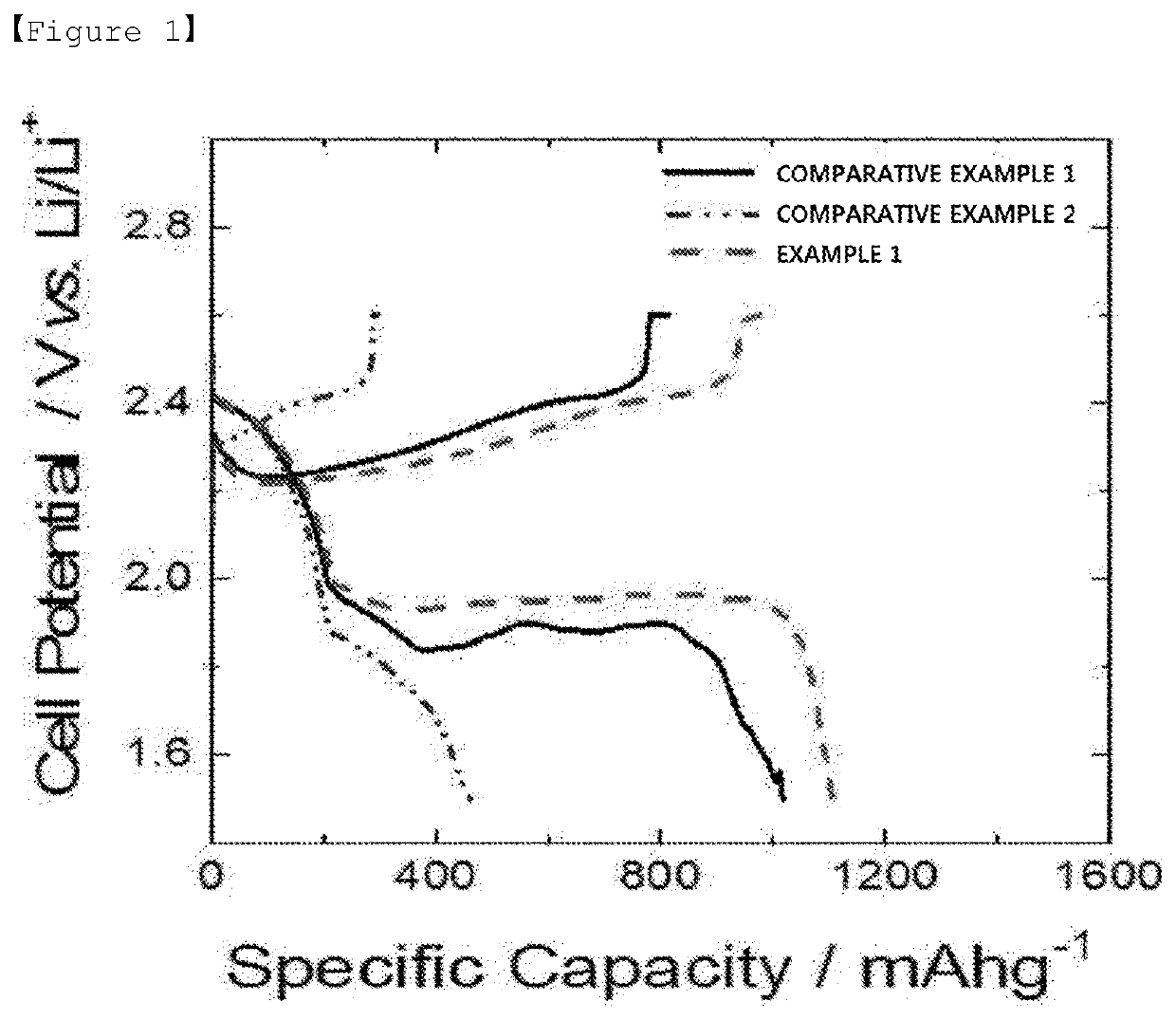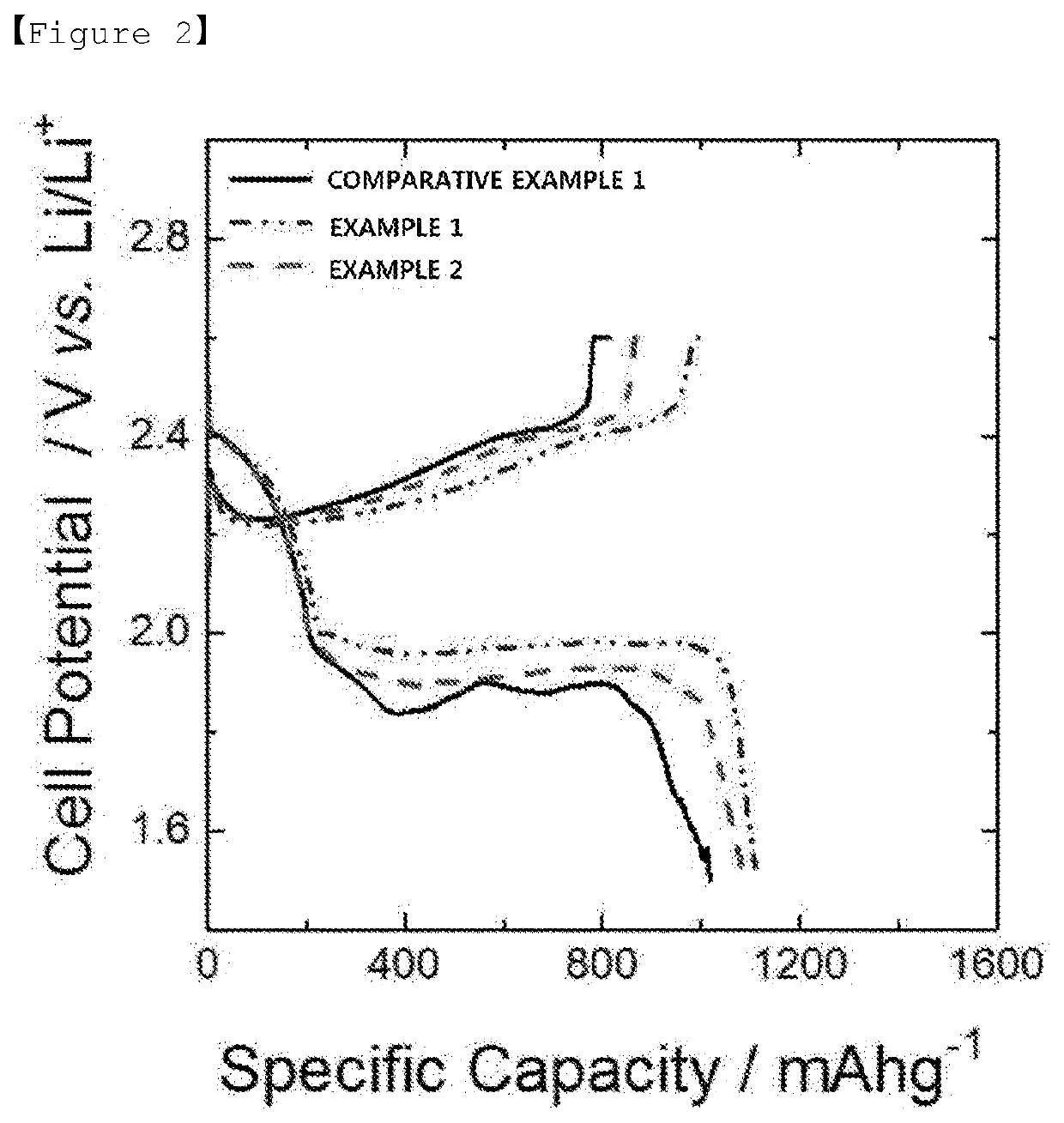Electrode and lithium secondary battery comprising same
a lithium secondary battery and electrode technology, applied in the direction of positive electrodes, active material electrodes, non-aqueous electrolyte accumulator electrodes, etc., can solve the problems of difficult commercialization, difficult to migrate electrons produced from electrochemical reactions, and low battery lifetime properties and rate properties, etc., to achieve excellent electrode reactivity, enhanced initial capacity, and increased porosity of electrodes
- Summary
- Abstract
- Description
- Claims
- Application Information
AI Technical Summary
Benefits of technology
Problems solved by technology
Method used
Image
Examples
example 1
re of Positive Electrode and Lithium-Sulfur Battery Comprising the Same
[0076]A sulfur-carbon composite that is a positive electrode active material was prepared in a ratio of 7:3, and after preparing positive electrode slurry by adding a positive electrode mixture including the sulfur-carbon composite in 88% by weight, carbon black that is a conductor in 5% by weight, styrene-butadiene rubber-carboxymethyl cellulose (SBR-CMC) that is a binder in 5% by weight and the additive for forming pores of Preparation Example 1 in 2% by weight to water that is a solvent, the positive electrode slurry was coated on an aluminum foil current collector, and a positive electrode was prepared with loading of 5 mAh / cm2.
[0077]A lithium-sulfur battery was manufactured using lithium foil having a thickness of 200 μm as a negative electrode, an organic solution dissolving 2% by weight of a LiNO3 additive in 1 M LiTFSI (DME / DOL, 1:1 volume ratio) as an electrolyte liquid, and a polypropylene film as a sep...
example 2
re of Positive Electrode and Lithium-Sulfur Battery Including the Same
[0081]A sulfur-carbon composite that is a positive electrode active material was prepared in a ratio of 7:3, and after preparing positive electrode slurry by adding a positive electrode mixture including the sulfur-carbon composite in 88% by weight, carbon black that is a conductor in 5% by weight, styrene-butadiene rubber-carboxymethyl cellulose (SBR-CMC) that is a binder in 5% by weight and the additive for forming pores of Preparation Example 1 in 5% by weight to water that is a solvent, the positive electrode slurry was coated on an aluminum foil current collector, and a positive electrode was prepared with loading of 5 mAh / cm2.
[0082]A lithium-sulfur battery was manufactured using lithium foil having a thickness of 200 μm as a negative electrode, an organic solution dissolving 2% by weight of a LiNO3 additive in 1 M LiTFSI (DME / DOL, 1:1 volume ratio) as an electrolyte liquid, and a polypropylene film as a sepa...
experimental example 1
[0089]For each of the positive electrodes prepared in Example 1 and Comparative Example 1, porosity was measured, and as a result, it was seen that porosity of Example 1 that is a positive electrode including the additive for forming pores was enhanced to 64% while porosity of Comparative Example 1 that is a positive electrode that did not include the additive for forming pores was 56%.
PUM
| Property | Measurement | Unit |
|---|---|---|
| particle diameter | aaaaa | aaaaa |
| porosity | aaaaa | aaaaa |
| porosity | aaaaa | aaaaa |
Abstract
Description
Claims
Application Information
 Login to View More
Login to View More - R&D
- Intellectual Property
- Life Sciences
- Materials
- Tech Scout
- Unparalleled Data Quality
- Higher Quality Content
- 60% Fewer Hallucinations
Browse by: Latest US Patents, China's latest patents, Technical Efficacy Thesaurus, Application Domain, Technology Topic, Popular Technical Reports.
© 2025 PatSnap. All rights reserved.Legal|Privacy policy|Modern Slavery Act Transparency Statement|Sitemap|About US| Contact US: help@patsnap.com


